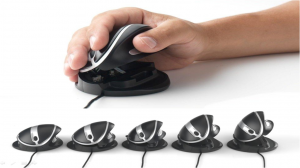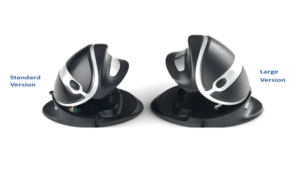Ergoption Oystermouse Review
Like most reviews sites, our editorial staff and laboratory testing expenses are partially offset by earning small commissions (at no cost to you) when you purchase something through those links. Learn More

Overview
| Review Summary |
We love adjustability. The business of ergonomics rarely smiles on one-size-fits-all solutions, not surprising given the enormous variety of body types, work styles, and personal quirks between workers. So we’re always pleased to see products like Ergoption’s Oystermouse. This clever little device brings ergonomic adjustment to mousing, and comes heavily recommended for anyone concerned about forearm RSIs. |
|---|---|
| MSRP / List Price | $ 129.99 |
| Where to buy |
Buy on Amazon |
Rating
| Expert Rating | |
|---|---|
| Positives | Wonderfully adjustable, any and all users will find it easy to reach a comfortable angle. Lefties can also get in on the ergonomic game, thanks to the ambidextrous design. Thumb buttons are easily reached and fully programmable. Comes in a wireless version, a major boon to the cable-challenged. |
| Negatives | Pinky buttons are set too far back for ergonomic use, on-off switch needlessly difficult to reach. |
Bottom Line
Review
Beneficial Bivalve
Ergonomic mice all address a couple of basic problems. The first, and most serious, is pronation. Flat mice force a user to rotate their mousing hand inward to operate them, a position that places stress on some parts of the forearm that you really don’t want stressed. Working with a consistent twist can crimp blood vessels, strain tendons and, given enough time, damage a major nerve. Designing a mouse with a sloping angle (from left to right, for right handed mice) removes that rotation, and makes mousing a much more comfortable prospect. Consequently, most ergonomic mice fall somewhere on what we like to call the “karate chop scale”. Some come slightly slanted while others, like the Evoluent, get your hand fully vertical (Chuck Norris impersonations encouraged while using them).
 The Oystermouse is a little different. Instead of sticking you on one point on the karate chop scale, it lets you select your favorite position. A locking ratchet hinge can be placed at 20, 30, 40, 50, or 60 degrees, a range sure to contain an ergonomic sweet-spot for most any user. It’s the first time we’ve seen anything quite like this, but it’s a major advantage. One-size-fits-all solutions generally don’t fit all, and often aren’t really solutions at all – adjustable products like the Oystermouse can find a home at any and all workstations.
The Oystermouse is a little different. Instead of sticking you on one point on the karate chop scale, it lets you select your favorite position. A locking ratchet hinge can be placed at 20, 30, 40, 50, or 60 degrees, a range sure to contain an ergonomic sweet-spot for most any user. It’s the first time we’ve seen anything quite like this, but it’s a major advantage. One-size-fits-all solutions generally don’t fit all, and often aren’t really solutions at all – adjustable products like the Oystermouse can find a home at any and all workstations.
Our one concern about the adjustable portion of the Oystermouse is durability. The mouse’s build trends toward the minimalistic in general, and there’s always a disconcerting “lord I hope I don’t break it” moment while ratcheting it about. Other reviewers have commented on this apparent flimsiness, but we’ve yet to see one who actually managed to break it. In the end, it’s a relatively minor gripe for such an ergonomically solid product.
Symmetrical Shellfish
The first interaction you’ll have with the Oystermouse is turning it on, which isn’t quite as easy as we’d like. While there is a friendly-looking switch on the underside of the mouse, it’s actually for switching the mouse between right and left handed modes (more on that later). To actually get the mouse working, you’ll have to pop it open, and flick the teeny switch hidden in its guts. It can be a bit of a pain for the fingernail-challenged among us, and also necessitates fully opening the mouse whenever you want to use it – a step generally followed by closing it and opening it back up to your preferred spot.
There’s not too much to say about the left and right buttons – they work, are satisfyingly responsive, and don’t require too much force. The center scroll wheel is also well-made, although one reviewer did mention he found it required more effort to press than he would have liked.
And yes, there’s a second scroll wheel. And a second left and right button. Ergoption loves them some lefties, and took an unusual design path to show it. The Oystermouse is symmetrical down to the buttons, and all it takes to change from left to right is the flick of a switch. Is this feature worth the design quirks? Absolutely. For one, it makes the Oystermouse more of a universal option. On top of that, some seasoned mouse users have learned to work ambidextrously – a skill that keeps one arm from receiving the brunt of a day’s work. The Oystermouse saves these folks the trouble of finding a second mouse.
 Oystermice come in a couple different options. Both wireless and wired versions are available. As born cable-haters, we’re major fans of the wireless option, which has proven response and reliable. Large and standard versions of the Oystermouse are also available – no specific sizing guidelines are available, but all testers here at the lab found the standard size comfortable.
Oystermice come in a couple different options. Both wireless and wired versions are available. As born cable-haters, we’re major fans of the wireless option, which has proven response and reliable. Large and standard versions of the Oystermouse are also available – no specific sizing guidelines are available, but all testers here at the lab found the standard size comfortable.
Why All the Buttons?
Ergonomic items often come loaded with all kinds of extra buttons. Most of these are designed to eliminate ergonomically questionable actions. Hotkeys in particular tend to be replaced by one-touch buttons. Copy and Paste are the two most common; they’re commonly used, and their keyboard key combos put some major stress on a typist’s hands and forearms.
The Oystermouse hotkey-killing answer is a small toggle-switch that fits under a user’s pinky, which doesn’t work. It’s best to be blunt about this one. The switch is hard to press, and consistent use would likely result in a new RSI. “Oyster pinky” sounds…appetizing? But seriously, be careful using that switch.
The two buttons on the opposite side of the mouse are much easier to operate. By default, they map to a double left-button click, which is handy, but not something we use all that much. All buttons are theoretically programmable, which does not necessarily mean easily programmable, and users have reported a fair dose of difficulty in repurposing them.

0 Comments
Leave a response >